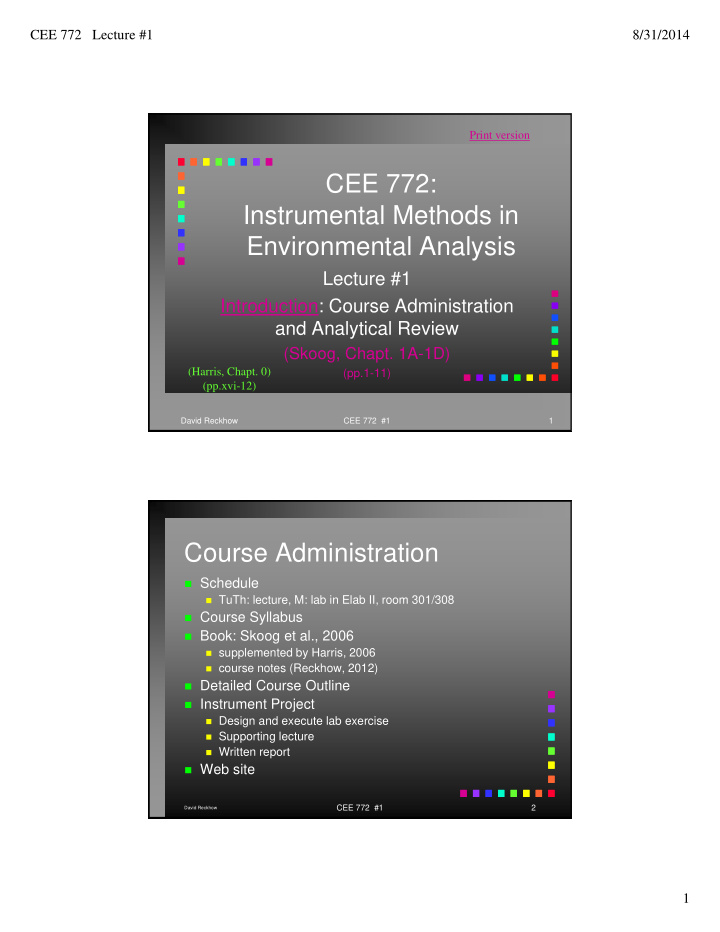



CEE 772 Lecture #1 8/31/2014 Print version CEE 772: Instrumental Methods in Environmental Analysis Lecture #1 Introduction: Course Administration and Analytical Review (Skoog, Chapt. 1A-1D) (Harris, Chapt. 0) (pp.1-11) (pp.xvi-12) David Reckhow CEE 772 #1 1 Course Administration Schedule TuTh: lecture, M: lab in Elab II, room 301/308 Course Syllabus Book: Skoog et al., 2006 supplemented by Harris, 2006 course notes (Reckhow, 2012) Detailed Course Outline Instrument Project Design and execute lab exercise Supporting lecture Written report Web site CEE 772 #1 2 David Reckhow 1
CEE 772 Lecture #1 8/31/2014 Relation with Environmental Engineering Math Environmental Biology Physics Engineering Chemistry CEE 772 #1 3 David Reckhow Relation with other Chemistry Disciplines Physical Analytical Chemistry Chemistry Inorganic Organic Chemistry Chemistry Chemistry 680 690K Thermodynamics Kinetics First of two courses on chemical analysis CEE 772 #1 4 David Reckhow 2
CEE 772 Lecture #1 8/31/2014 Questions for Environmental Analytical Chemists How do we assess water quality? What to measure, when and why How do we do it? Gravimetry, titrimetry, spectrophotometry, chromatography What can chemical analysis tell us? What can’t it be used for? What is the significance of WQ parameters? Metals, nutrients, solids, organics? How should samples be collected and preserved? How do we spot blunders? How sure can we be of the measurements? CEE 772 #1 5 David Reckhow Why learn WQ analysis? You may have to make these measurement yourself As a consultant As a utility or industrial employee As a graduate student You may need to interpret and critique water quality data collected by others You may need to select the types of water quality analyses required for a particular job CEE 772 #1 6 David Reckhow 3
CEE 772 Lecture #1 8/31/2014 Review Laboratory Basics Chemical CEE 577 Stoichiometry Early Chapters in Harris mass balance Units balancing equations Mass based Thermodynamics Molarity Molality law of mass action Normality types of equilibria Mole fraction Atmospheres CEE 772 #1 7 David Reckhow CEE 772 #1 8 David Reckhow 4
CEE 772 Lecture #1 8/31/2014 Chemical Equilibria Law of mass action equilibrium quotients Examples ion product of water acid dissociation precipitation redox adsorption volatilization CEE 772 #1 9 David Reckhow Personal Safety Lab coats Recommended for protection from acids & bases Goggles Especially important if you don’t wear shatter- proof glasses Gloves Latex: good flexibility, but leaky Butyl rubber: much better General Avoid loose fitting clothing CEE 772 #1 10 David Reckhow 5
CEE 772 Lecture #1 8/31/2014 Lab Safety Washes Eye wash Squeeze bottle Plumbed fixture Drench Shower CEE 772 #1 11 David Reckhow Eye wash In Attleboro WTP CEE 772 #1 12 David Reckhow 6
CEE 772 Lecture #1 8/31/2014 Lab Safety Fire Extinguisher Fire blanket General: EH&S safety manual http://www.umass.edu/safety/lhs.html CEE 772 #1 13 David Reckhow Vapors Fume hood Face velocities Sash position EH&S standards http://www.umass.edu/safety/fume-hood.html CEE 772 #1 14 David Reckhow 7
CEE 772 Lecture #1 8/31/2014 Disposal General waste Non recyclables Recyclable materials Paper, plastic Non hazardous Chemical waste Organic waste (container with EH&S hazardous waste label) Aqueous waste (flushed down a drain after pH neutralization) Hazardous wastes Definitions Typical Examples CEE 772 #1 15 David Reckhow To next lecture CEE 772 #1 16 David Reckhow 8
Recommend
More recommend